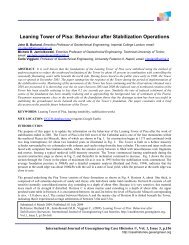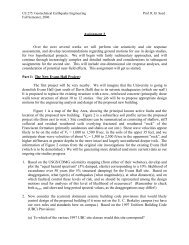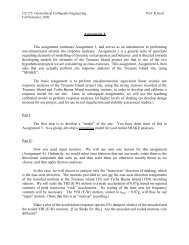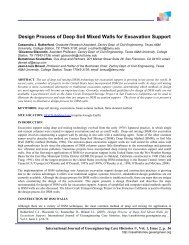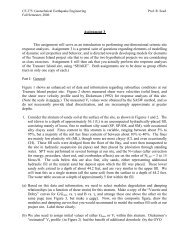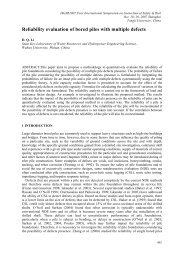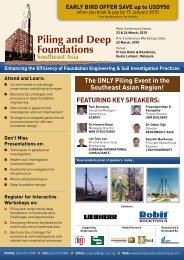Risk Assessment and Management for Offshore ... - GEOSNet
Risk Assessment and Management for Offshore ... - GEOSNet
Risk Assessment and Management for Offshore ... - GEOSNet
You also want an ePaper? Increase the reach of your titles
YUMPU automatically turns print PDFs into web optimized ePapers that Google loves.
(hazard) in most cases has to be based on a combination of field observations, dating of earlier<br />
events <strong>and</strong> geotechnical analyses of the failure scenarios. Reliability theory <strong>and</strong> probabilistic<br />
analyses provide a rational framework <strong>for</strong> estimating the probability of slope failure <strong>and</strong> are<br />
powerful tools <strong>for</strong> quantitative risk assessment. However, reliability methods require more data<br />
<strong>and</strong> estimates of the variances in significant parameters. This can be expensive <strong>and</strong> it will also<br />
require expert judgment. The cost <strong>and</strong> judgment are part of the price paid <strong>for</strong> a better answer.<br />
Lacasse <strong>and</strong> Nadim (2007) summarise the most common tools <strong>for</strong> probabilistic slope stability<br />
evaluation, namely the first-order, second-moment (FOSM) approach, first- <strong>and</strong> second-order<br />
reliability methods (FORM <strong>and</strong> SORM), Monte Carlo simulation, <strong>and</strong> event tree analysis. Note<br />
that these methods aim at estimating the probability of failure (i.e. hazard), which is only one<br />
component of risk. Consequence analysis is just as important as the hazard estimation, <strong>and</strong> it<br />
sometimes involves even greater uncertainties.<br />
The ideal solution would be probabilistic analysis of complete mechanical scenario models<br />
with full interaction between soils, structures, environmental <strong>and</strong> geological processes <strong>and</strong> load<br />
effects in space <strong>and</strong> time. This is not feasible in the <strong>for</strong>eseeable future, <strong>and</strong> the analyses have to be<br />
split in separate sequences with considerable simplifications <strong>and</strong> approximations.<br />
The probabilistic slope stability analyses take into account the uncertainties within the system<br />
<strong>and</strong> provide an estimate of the probability that a system, if “built” today, would fail immediately.<br />
This is a straight<strong>for</strong>ward interpretation <strong>for</strong> man-made slopes like earth dams <strong>and</strong> embankments.<br />
For natural slopes this interpretation is not relevant. As the slope has not failed today, its<br />
probability of “static” failure is zero, since as long as there are no triggers causing changes to the<br />
system, a slope that st<strong>and</strong>s today would never fail. There<strong>for</strong>e, the failure probability provided by<br />
the probabilistic slope stability analysis is not an indicator of the annual probability of failure <strong>for</strong><br />
natural slopes.<br />
Two types of triggering mechanisms typically to be considered in the slope stability evaluation<br />
<strong>for</strong> a submarine slope: rapidly acting triggers like earthquakes <strong>and</strong> wave loading, <strong>and</strong> slowly<br />
varying triggers like sediment deposition <strong>and</strong> fault or diapir displacements. The rapidly acting<br />
triggers are discussed <strong>and</strong> evaluated by Nadim et al. (2005), <strong>and</strong> the slowly varying type by<br />
Nadim et al. (2003) <strong>and</strong> Lacasse <strong>and</strong> Nadim (2007). Regarding the seismic triggering mechanism,<br />
Probabilistic Seismic Hazard <strong>Assessment</strong> (PSHA) provides site-specific earthquake load<br />
characteristics, like peak ground acceleration <strong>and</strong> response spectrum, vs. recurrence period. This<br />
allows a connection to be established between seismic load intensity <strong>and</strong> recurrence period, which<br />
again can be trans<strong>for</strong>med to a relationship between recurrence period <strong>and</strong> post-earthquake strength<br />
reduction of the sediments, <strong>and</strong> finally to an annual probability of earthquake-induced failure.<br />
When the occurrence frequency or the development rates of triggering sources are estimated,<br />
tectonic <strong>and</strong> climate changes must be taken into consideration. Glacial cycles with eustatic sea<br />
level variations have had a strong impact on sediment deposition rates on the continental slopes<br />
<strong>and</strong> <strong>for</strong>mation of major river delta <strong>and</strong> glacial fan structures. Many of the major submarine slide<br />
events seem to be connected to these variations, <strong>and</strong> the present interglacial climate with sea level<br />
high-st<strong>and</strong> is generally associated with strongly reduced sedimentation rates along the deepwater<br />
margins. A reduction in sedimentation rate below a certain value will lead to a gradual reduction<br />
in excess pore pressure <strong>and</strong> thus a gradual improvement of slope stability. A comparison of slump<br />
rate vs. sedimentation rate was described <strong>for</strong> the drape sediments at Sigsbee Escarpment, Nadim<br />
(2003) <strong>and</strong> showed a clear reduction in slump rate with decreasing deposition rate.<br />
7.2 Systematic approach to consequence estimation<br />
The potential consequences of the failure scenarios have to be estimated from an engineering<br />
point of view, as well as from health <strong>and</strong> safety, <strong>and</strong> economic points of view. A systematic<br />
compilation of estimated damage vs. estimated probability of occurrence is required <strong>for</strong> all<br />
identified failure scenarios to assess the cumulative geohazard risk. General techniques <strong>for</strong> risk<br />
evaluation (event tree <strong>and</strong> fault tree analyses, risk matrices etc.) can be applied.<br />
Typical consequences are related to:<br />
- Loss of foundation support or capacity causing tilting, sinking, pull-out of piles, anchor<br />
<strong>and</strong> mat foundations<br />
168



